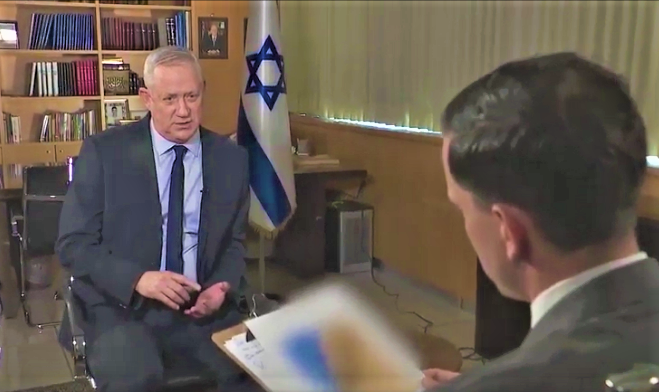In a Fox News interview, Israel had top secret maps of Lebanon blurred, except for previously unrevealed Hezbollah bases there.
By Yakir Benzion, United With Israel
Israel knows that terror groups pay close attention to news about the Jewish state.
In a recent TV interview, Defense Minister Benny Gantz showed how Israel sends messages to the Iran-backed Hezbollah terror group in Lebanon.
Gantz communicated to Hezbollah that their secret strategies aren’t so secret, reported the terrorism monitoring site Long War Journal (LWJ).
Interviewed on Fox News last week, Gantz talked about the situation in Lebanon, where Hezbollah has been threatening for years to attack Israel and helping Iran in its attempt to destroy the Jewish State.
Gantz showed some apparently declassified materials, however, some of the sensitive images were noticeably blurred out by the military censor before the clip was broadcast on Fox – except the censor apparently left some areas of the map conspicuously not blurred.
LWJ noted that Israeli officials have previously revealed declassified material about Hezbollah to the public, but the way that Gantz did it “was somewhat peculiar.”
The Fox interviewer asked Gantz about how many missiles Hezbollah had in its possession and Gantz replied “hundreds of thousands.”
Gantz then showed the interviewer a map of Lebanon that was digitally blurred by the Israeli Military Censor so viewers couldn’t see the details. Gantz said that the map showed the locations of Hezbollah ground forces, missiles, headquarters and launching sites, pointing out that “everything is aimed at [Israeli] civilian targets and everything is being conducted from [Lebanese] civilian infrastructure” areas.
Although the digital blurring seemed to cover the entire map, when Gantz handed the map to the interviewer, a small portion of northern Lebanon was not blurred.
“This was not an oversight by the Israeli Military Censor,” LWJ reported.
“By analyzing frames of the interview, the unblurred image of the map shows northern Lebanon marked by black dots that are presumably locations of Hezbollah sites in northern Lebanon,” said Joe Truzman, a research analyst at the Foundation for the Defense of Democracies (FDD), which publishes LWJ.
“The disclosure of sensitive locations was done to convey a message to Hezbollah that Israel was aware of the locations of its military infrastructure,” Truzman noted.
The disclosure of sensitive intelligence about Hezbollah military sites embedded within the civilian population of Lebanon is part of a strategy by Israel to publicize Hezbollah’s military efforts so if conflict were to break out, Israel would be justified in protecting itself from attacks if they emanated from populated locations, Truzman added.
“It is unlikely the Israeli Military Censor blundered by allowing sensitive military intelligence to be made public, thus allowing some of the map to be shown — albeit briefly — knowing that Hezbollah monitors news about Israel and would notice the unblurred image in the interview,” Truzman concluded.
